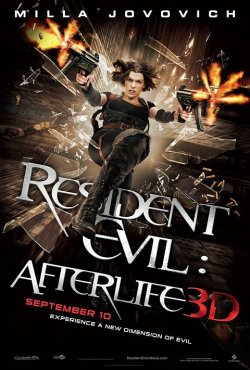Review: Resident Evil: Afterlife (2010)
 Note: This post contains a portion of a review originally written for CaryCitizen. To read the full review, click here.
Note: This post contains a portion of a review originally written for CaryCitizen. To read the full review, click here.
If there’s any film series that exemplifies its own subject matter, it’s the Resident Evil films. Despite terrible reception from critics and declining popular appeal, each successive chapter continues to pass its predecessor in box-office returns, perhaps proving once and for all that people will watch just about anything. As a result, just when it looks like the series is finally finished, it pops back up again like a rotting, undead corpse. Resident Evil: Afterlife is its latest resurrection.
Paul W.S. Anderson, the director of the somewhat-liked first movie, has returned in the hopes of assuaging the feelings of fans who were let down by the sequels. Apparently mainstream cinema has fallen so low that the ability to reach mediocrity is now an effective marketing tool. Anderson is living the Hollywood dream, somehow managing to keep finding directing work despite a track record that would make Uwe Boll blush.
Compared to the first two entries of the series, 2007’s Resident Evil: Extinction was a breath of only slightly stale air, managing to attain some level of narrative coherence and solid filmmaking technique. At the very least, it provided some compelling plot twists and schlocky genre fun. It ended with protagonist and token female badass Alice (Milla Jovovich) gazing out over an army of genetically engineered clones of herself. Having located the head of the evil Umbrella Corporation in Japan (where else would a video game villain reside but in the birthplace of Sony and Nintendo?), she vowed to finally put an end to his zombie-making shenanigans. Also, she had developed psionic abilities, making her essentially a much sexier version of Luke Skywalker. That alone was enough to provide me with a slight amount of optimism regarding the sequel. Alas, it was not meant to be.